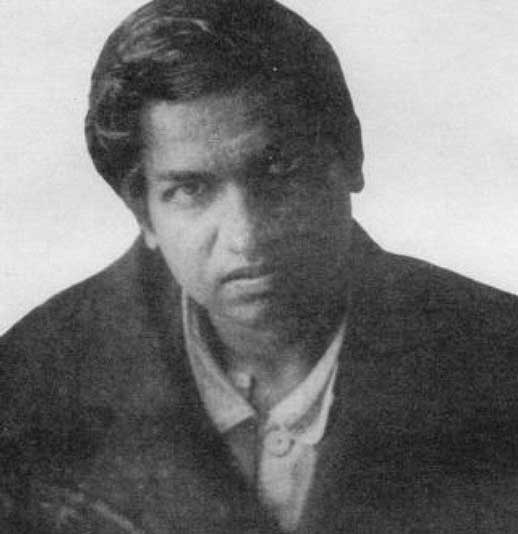Robert Kanigel's biography of Srinivasa Ramanujan, the Indian mathematician—originally a clerk in the Accounts Department of the Port Trust Office at Madras on a salary of only £20 per annum—tells a fascinating story of genius and the famed collaboration Hardy arranged at Cambridge.
 Srinivasna Ramanujan
Srinivasna Ramanujan
Ramanujan introduced himself in a now famous letter to G.H. Hardy, a mathematician and leader in his field. Hardy arranged his travel to, and stay at Cambridge, becoming both mentor and collaborator.
Here’re excerpts from Ramanujan's January 16, 1913 letter:
“I am now about 23 years of age. I have had no University education but I have undergone the ordinary school course. After leaving school I have been employing the spare time at my disposal to work at Mathematics. I have not trodden through the conventional regular course which is followed in a University course, but I am striking out a new path for myself. I have made a special investigation of divergent series in general and the results I get are termed by the local mathematicians as startling."
He concludes, “I would request you to go through the enclosed papers. Being poor, if you are convinced that there is anything of value I would like to have my theorems published. I have not given the actual investigations nor the expressions that I get but I have indicated the lines on which I proceed. Being inexperienced I would very highly value any advice you give me.
Requesting to be excused for the trouble I give you,
I remain, Dear Sir, Yours truly,
A. S. Ramanujan.”
Kanigel's meticulous research enables him to explore—he does so faithfully—elements of the man, South India and Cambridge that led to the "collaboration" which allowed Ramanujan to flourish and be "discovered" by the West.
Whereas Mathematics and Science are indeed boundless—Planetary in scope—cultures and colonialism, idiosyncrasies of universities, constraints of poverty, all in some way, may deny us the fruits of genius, whom I daresay are "normally" distributed in all populations!
Nurture, in the true and fullest sense of the word, allows the light to shine through. Ramanujan had previously, attempted correspondence with established mathematicians in the UK, two of whom returned his papers without comment. The general feeling seems to have been that Ramanujan, while exhibiting ability and enthusiasm for the subject, lacked the educational background and foundational building blocks for ‘formal acceptance’ among mathematicians.
Persevering, Ramanujan finally wrote his ‘letter to Hardy’—a classic! One might describe its composition as the essence of understatement. Uneducated in the purely formal sense he may have been, but he was quite aware of the world he was to be reluctantly invited to join. His gifts rare, his powers abundantly evident, he died at the young age of 32. There's little use debating how much longer he may have lived, how much more he would have created, had both he and Hardy understood the difficulties of a South Indian clerk of that era, attempting to live in Cambridge.
Prior to his fateful decision to invite Ramanujan to Cambridge, Hardy’s thoughts could hardly avoid recurring consideration of the Indian manuscript. Was this the work of a fraud of genius, or a mathematician of genius? He had never before seen, nor imagined the theorems accompanying Ramanujan's unsolicited letter.
Ultimately, he believed Ramanujan’s ‘results’ were more likely the work of an unknown mathematician of genius. Together, Ramanujan and Hardy would produce five papers of the highest class.
Their successful collaboration brings into sharp relief, the generally accepted notion that in most human endeavours critical mass, or an informed bouncing wall/mirror fosters performance at its best. Would Serena Williams, Raphael Nadal or Roger Federer achieve their best in competition with weak opponents? Would Karpov have further ramped up his game had Fischer allowed him a match? Point is for Ramanujan, even if it were merely Hardy's genuine interest and searching queries about his 'new path' and 'special investigations', such interest and encouragement were likely inspirational.
Bertrand Russell alerts us to Hardy's enthusiasm in a 2nd February 1913 letter to Ottoline Morrell with this comment: “ . . . In Hall I found Hardy and Littlewood in a state of wild excitement, because they believe they have discovered a second Newton, a Hindu clerk in Madras on £20 a year. He wrote to Hardy telling him of some results he has got, which Hardy thinks quite wonderful, especially as the man has had only an ordinary school education.”
Undoubtedly Ramanujan would've contributed much more had he survived a mere two more Cambridge Summers. Nevertheless, as it stands his original and innovative contribution is outstanding! His notebooks contain formulae and equations as yet unproved. They still give up useful gems to knowledge-hungry post-graduate students. Freeman Dyson, of Princeton's Institute for Advanced Study, suggested Ramanujan " . . . had some sort of magic tricks that we don’t understand."
Magical tricks aside, Bruce Berndt, Professor of Mathematics at the University of Illinois insists that such ideas are " . . . falsely promulgate[d] mystical powers [attributed] to Ramanujan's mathematical thinking. It is not true. He has meticulously recorded every result in his three notebooks." Berndt should know for he spent 20 years absorbing the pages of those notebooks!
Prior to his efforts while at Cambridge, Ramanujan committed more than 3000 theorems to his notebooks. As indicated to Hardy in his letter, he generally provided results without proofs. Kanigel details his working method—he expressed his thoughts and equations with pencil on a slate. As Berndt persuasively contends, this practice developed because for Ramanujan, paper was a big expense he couldn't afford. Saving costs, he recorded his results in the notebooks without proofs, " . . . not because he got the results in a flash."
Finally, it's interesting to relate an incident Kanigel recounts. While Ramanujan was hospitalised in Cambridge being treated for tuberculosis, Hardy visited with him. C. P. Snow conveys the interchange in his 1967 foreword to Hardy’s “A Mathematician’s Apology” thus: “He went into the room where Ramanujan was lying. Hardy, always inept about introducing a conversation said, probably without greeting, and certainly as his first remark: I thought the number of my taxicab was 1729. It seemed to me a rather dull number. To which Ramanujan replied: No Hardy, No, Hardy, it is a very interesting number; it is the smallest number expressible as a sum of two cubes in two different ways."
Such observations were never magical insights or revelations of an autistic savant. Berndt in an interview insists " . . . this was no flash of insight, as is commonly thought." Ramanujan, he notes, actually recorded this result in one of his notebooks predating his sojourn at Cambridge. Furthermore, the incident demonstrates Ramanujan's love of numbers and their properties. One should perhaps add: their properties—interesting and mysterious—yet discernible to "the man who knew infinity!"
Kanigel's book is a must read for anyone interested in the history of Mathematics, anyone interested in understanding or rousing the powers of genius, or grasping the complex relationships among nature and nurture, genes and culture etc. It should also be highly recommended reading for teachers of mathematics, perhaps especially those toiling in classrooms of the poor! Good companion reading would include the lives of Richard Feynman, John Maynard Keynes and anything on the Manhattan Project to name but a few.



